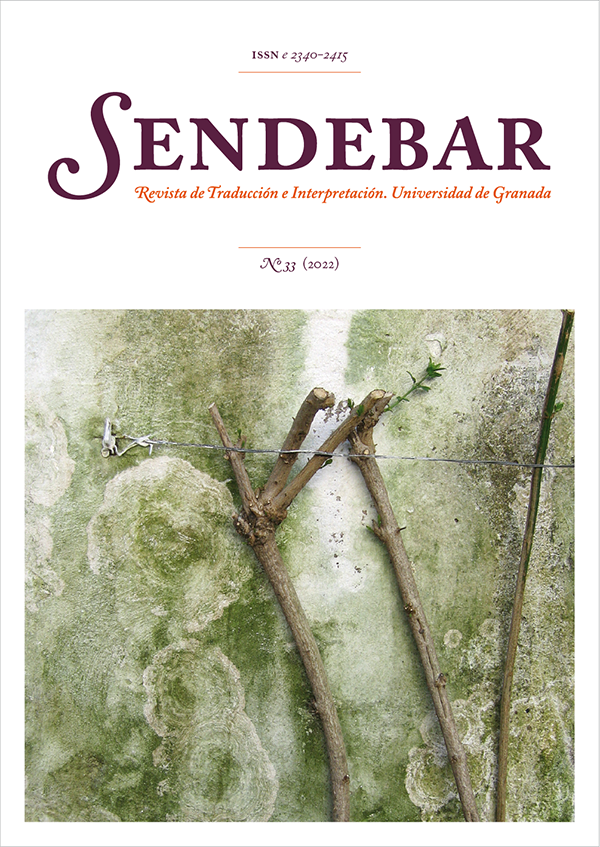Hopscotch by Gregory Rabassa: the Challenge of Translating Rayuela
DOI:
https://doi.org/10.30827/sendebar.v33.22759Keywords:
Julio Cortázar, Rayuela, translation, Hopscotch, Gregory RabassaAbstract
In the following paper a comparative analysis between Rayuela and Hopscotch is carried out, the translation by Gregory Rabassa into English. The Julio Cortázar’s opinion on translation process is also analyzed, through his letters, and also his degree of involvement in the translation. Likewise, the modifications the translator was obligated to make are enquired, pointing to linguistic and stylistic matters, to determine in what way is Julio Cortazar’s writing projected in this language whose stylistic features aren’t its own. The adopted methodology starts from system theory, that is, it has sought to link the changes operated by Rabassa with the difference between the original novel’s ideology textual and that of its translation, in order to transcend immanentist purposes through a translation’s socio-critical reading.
Downloads
References
Aebi, M. (1993). «Marelle Hopscotch Coxcoyilla» Julio Cortázar y las lenguas de Rayuela, en Literatura y bilingüismo. Homenaje a Pere Ramírez (pp. 367-384). Reichenberger.
Amorós, A. (2013). Introducción. En Rayuela de Julio Cortázar (pp. 13-110). Cátedra.
Blomgren, E. (2011). La traducción del español argentino en Rayuela de Julio Cortázar. Universidad de Göteborgs.
Booth, W. (1961). The Rethoric of Fiction. Chicago University Press.
Borinsky, A. (1991). Rayuela: avenidas de recepción. En J. Ortega, & S. Yurkievich (Eds.), Rayuela de Julio Cortázar (pp. 651-659). Fondo de Cultura Económica.
Bracco, E. (2018). Del lado de allá: un estudio sobre cómo Rayuela de Cortázar fue traducida al inglés y publicada en los Estados Unidos. Hyperborea. Revista de ensayo y creación, 1, 1-9.
Casanova, P. (2001). La República mundial de las Letras. Anagrama.
Castro-Klarén, S. (1991). Rayuela: los contextos. En J. Ortega, & S. Yurkievich (Eds.), Rayuela de Julio Cortázar (pp. 639-650). Fondo de Cultura Económica.
Cortázar, J. (1966). Hopscotch, trad. de Gregory Rabassa. Pantheon Books.
Cortázar, J. (1967b). Marelle, trad. de Laure Guille- Bataillon. Gallimard.
Cortázar, J. (1983). Cuaderno de bitácora de Rayuela, ed. de Ana María Barrechenea. Sudamericana.
Cortázar, J. (2007). Translate, traduire, tradurre, traducir. En S. Yurkievich (Ed.), Obras Completas, (vol. VI, pp. 80-82). Galaxia Gutenberg.
Cortázar, J. (2012). Cartas, Alfaguara.
Cortázar, J. (2013). Rayuela. Cátedra.
Damrosch, D. (2003). What is World Literature. Princeton University Press.
Dougherty, C. (2013). Posibilidades de la abstracción: la obsesión y la traducción en los cuentos de Julio Cortázar. Tesis Doctoral, Oberlin College, Ohio: https://etd.ohiolink.edu/apexprod/rws_etd/send_file/send?accession=oberlin1367956286&disposition=inline
Everly, K. A. (1997). George D. Schade: una breve historia de nuestros tiempos literarios. Dactylus, XVI, 15-24.
Fernandes, N. (2010). ¿Maler les vinges por amalar el noema? Traducción del glíglico del capítulo 68 de Rayuela. Jornadas Andinas de Literatura Latinoamericana, Río de Janeiro, [1-13].
Fogsgaard, L. (1998). El juego lingüístico de Julio Cortázar. En Estudios de lingüística textual: homenaje al profesor Muñoz Cortés (pp. 187-196). Universidad de Murcia.
Fouces González, C. G. (2005). Estrategias interpretativas en las traducciones italianas de Julio Cortázar e Isabel Allende. Tonos digital: Revista electrónica de estudios filológicos, X, [1-10].
Gilman, C. (2003). Entre la pluma y el fusil. Debates y dilemas del escritor revolucionario en América Latina. Siglo Veintiuno Editores.
Iber, P. (2015). The Cold War Politics of Literature and the Centro Mexicano de Escritores. Journal of Latin American Studies, 48, 247-272.
Ilian, I. (2004). Puentes entre los puentes de Rayuela, Primer foro internacional sobre traducción especializada “Julio Cortázar y la traducción”, [1- 14].
Iser, W. (1989). La estructura apelativa de los textos. En R. Warning (Ed.) Estética de la recepción (pp. 133-148). Visor.
Locane, J. J. (2021). Literatura comunista mundial. En G. Guerrero, B. Loy, & G. Müller (Eds.), World Editors. Dynamics of Global Publishing and the Latin American Case between the Archive and the Digital Age (pp.191 207). De Gruyter.
Logie, I. (2003). Plurilingüismo y traducción en la obra de Julio Cortázar. Ciberletras: Revista de crítica literaria y de cultura, X, [1-12].
Malmkjaer, K. (1998). Translation and Language Teaching. Language Teaching and Translation. Manchester: St. Jerome Publishing.
Molloy, S. (2005). Postcolonial Latin America and the Magic Realist Imperative: A Report to an Academy. En S. Bermann, & M. Wood (Eds.), Nation, Language, and the Ethics of Translation (pp. 370-380). Princeton University Press.
Montaldo, G. (1991). Destinos y recepción. En J. Ortega, & S. Yurkievich (Eds.), Rayuela de Julio Cortázar (pp. 597-612). Fondo de Cultura Económica.
Moretti, F. (2006). Dos textos en torno a la teoría del sistema-mundo. En I. Sánchez Prado (Ed.), América Latina en la «literatura mundial» (pp. 47-62). Instituto Internacional de Literatura Iberoamericana.
Munday, J. (2008). Style and Ideology in Translation. Latin American Writing in English. Routledge.
Nord, C. (1993). La traducción literaria entre la intuición y la investigación. En M. Raders, & J. Sevilla Muñoz (Eds.), III Encuentros Complutenses en torno a la traducción (pp. 99-109). Universidad Complutense de Madrid.
Protin, S. (2005). Pari(s): la apuesta del Cortázar traductor. Cuadernos hispanoamericanos, 658, 33- 38.
Protin, S. (2012). Del otro lado o el mirar del traductor. Centre de Recherches Latino-Américaines, 5, [s. p.].
Rama, Á. (1981). Más allá del boom. Literatura y mercado. Marcha.
Sánchez, P. (2009). La emancipación engañosa: una crónica transatlántica del boom (1963-1972). Universidad de Alicante.
Torralbo Caballero, J. (2011). La (in)traducibilidad de un texto literario: nullum est iam dictum quod non dictum sit prius. Estudios de traducción, 1, 39 57.
Vukadinović, U. K. (2017). Las palabras culturales en las traducciones al esloveno de las obras de Juan Rulfo y Carlos Fuentes. Verba hispánica, XXIV, 53-69.
Downloads
Published
How to Cite
Issue
Section
License
Terminos de Licencia Sendebar.

















